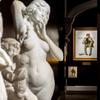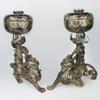Impressions of Innocence: Dorothea Sharp
- July 25, 2016 15:31
Spontaneity. Pure color. Rapid brushstrokes. These and more are words that come to mind when envisioning the impressionist style, and all embody the oeuvre of the British artist Dorothea Sharp. Yet, unlike the Impressionists who came before her and served as her inspiration, Sharp’s extraordinary canvases also evoke another word: innocence. Her charming scenes capture the simple joys of childhood through swift brushstrokes and bright hues that mimic the energetic lightness of youth. Perhaps more than any other British artist, she understood the simple pleasures of everyday life through the eyes of a child. The result is stunningly rendered, endearing scenes that are both nostalgic and idyllic, and which conjure the purest memories of one’s childhood.
Born in an age when women were expected to aspire solely to a good marriage and motherhood, Sharp’s path to artistic fame was far less idyllic. Like many female artists of her day, Sharp was deeply discouraged by her family to pursue her interests in the arts. Thus, her career did not begin in earnest until the age of twenty-one, when she inherited £100 from an uncle and was able to fund her own education. Her early years as an artist were largely influenced by the English painter George Clausen, and echoes of his style – particularly his renderings of light – can be seen even in her later works. Yet, a visit to Paris would have the most profound effect on her stylistic development, for it was there that she first encountered the work of Claude Monet and the Impressionists.
The spontaneity and boldness of the Impressionist’s canvases enamored Sharp, and her working style abruptly and permanently shift to embrace the ideals of the modern French art form. Inspired by Monet in particular, Sharp sought to replicate his revolutionary technique of using brilliant color to capture both shadows and light. Her masterful grasp of color theory seemed instinctive, and even today her works are admired for their bright, complementary color palettes. As she once said, “Colour is emotional - it is felt, in its finer sense rather than seen.” (The Artist Magazine, April 1931, p48)
In the years after adopting her new style, she quickly rose to fame in the art world, and in 1935 the editor of The Artist Magazine described her as "one of England's great women painters.” Though she never married, her admiration for motherhood and children is plain to see in her enchanting works. What is also clear is that her young subjects were relaxed in her presence, and as a result her works are free from any artificiality or pretension, simply depicting the happiness of youth at its purest.
About M.S. Rau Antiques:
M.S. Rau Antiques has spent over 100 years earning the trust of discerning collectors world-wide. Located in the heart of New Orleans’ historic French Quarter, our peerless showroom houses one of the world’s most extensive and stunning collections of important fine art by artists such as Monet and de Kooning, 18th-and 19th-century antiques, and breathtaking jewelry, including rare colored diamonds.


















100x100_c.jpg)


